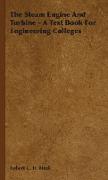The Steam Engine and Turbine - A Text Book for Engineering Colleges
BücherAngebote / Angebote:
THE STEAM ENGINE AND TURBINE- A TEXT BOOK FOR ENGINEERING COLLEGES by EGBERT C. H. HECK, M. E. Professor of Mechanical Engineering. First published in 1911. PREFACE: IN part this book is adapted from the writers STEAM ENGINE AND OTHER STEAM MOTORS, in larger part it is rewritten or newly written. The textbook idea and the purpose of class-room use have continually been kept in mind. Mechanical form and manner of working are illus trated by selected, typical examples of construction rational theory is built up, from fundamental concepts to the fully-developed ideal steam engine and actual performance is studied and compared with the ideal, an especial effort being made to set forth clearly and logically the empirical knowledge which must fill the gap between them. Viewing the steam plant as a whole, a line is drawn between the members that have to do with the generation and impartation of heat, and those concerned with its conversion into work through the agency of steam. In other words, the furnace and boiler, with their acces sories, are taken to constitute a subject for treatment elsewhere, except that allusion is freely made to their functions. But on the side of the steam machine a comprehensive presentation is undertaken to the writer it appears that the study of the piston engine and of the turbine can most effectively and profitably be combined in a single course. It is assumed that the student approaches the subject with at least a general knowledge of the form and working of the steam plant, and with a good preparation in the elements of physics and of mechanics. All deductions along the latter lines begin, however, with basal facts or principles, so that the book shall be self-contained on that side. In the matter of thermodynamics, which is carried only so far as it is of immediate use and application, a special effort is made to develop con cepts and ideas, not merely to build up a mathematical, abstract struc ture on a few axioms. An excess of mathematics is avoided, preference being largely given to graphical methods. Many numerical examples illustrate and enforce the text, emphasize the quantitative side of the subject, and will suggest problems for class-room use. Certain omissions imply supplementation by other parts of the cur riculum. Directions for making tests are left to the laboratory course, although the purpose of such tests, the quantities sought, and the manner of workup are fully indicated. Design goes no farther than proportioning of the parts that have to do with steam action, not ex tending into the field of machine design. Plant layout and economics, to a generally sufficient extent, can be covered by a few lectures, with visits of inspection. Engine or plant manipulation is hardly a matter to be learned from books. A new steam table is presented, differing slightly from that of Marks and Davis, but founded on the same experimental data. For saturated steam, it was worked out before the latter appeared in continuity and smoothness it is a little better, especially in the high range of pressure while for superheated steam, the line of equal temperature, used in Table VII and described on page 86, is a new and most effective means of correlating data as to total heat. As between engine and turbine, the former receives much the larger share of space, although the difference is less than may appear, since Chapters I to IV and the first part of Chapter VI apply to both. Of in tention, however, the engine is given fuller treatment the problems of its intimate behavior have been more fully worked out or solved by experience, so that they come within textbook scope and a general text . like this may aim to be fairly complete, within its field, for the engine, while very properly making frequent reference to large and special works on a growing subject, such as Stodolas Steam Turbines...
Folgt in ca. 15 Arbeitstagen
